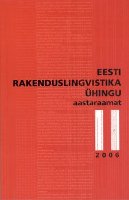Mitte-eestlastest noorte kohanemine eestikeelses töökeskkonnas
The adjustment of the non-Estonian youths into the Estonian speaking work environment
Author(s): Elvira KüünSubject(s): Language and Literature Studies
Published by: Eesti Rakenduslingvistika Ühing (ERÜ)
Keywords: integration; language policy; bilingualism; second language acquisition; Estonian as a second language
Summary/Abstract: Integration is a national policy of Estonia. We aim to create the Estonian model of a balanced multicultural society in which the ethnic differences do not restrain any individual’s personal enhancement. Such a society is characterised by everyone’s opportunity of fulfilment of his/her personal potential, by the strong common core of the society and by the central role of the Estonian culture. Currently there are over 100 non-Estonian nationalities and ethnic groups in Estonia. The major obstacle that prevents most of these people from participating in the Estonian life and from having better opportunities in the labor market is the insufficient knowledge of the Estonian language. The language barrier has created a situation that the non-Estonians feel being trapped into their own world. The opinion surveys conducted in the recent years have revealed a potential threat: the development of two different societies in Estonia, both having their own language and mentality. We shouldn’t lose time in removing the barriers between the Estonian and non-Estonian communities. There are two parallel processes in harmonizing the multiethnic society. The first process in the social harmonization of the society is the minorities acquiring a basic knowledge of Estonian and the Estonian citizenship. The second process is the preservation of the ethnic differences though recognition of the cultural right of the ethnic minorities. The components of the Estonian integration policy are: orientation to the future; focus on the children and the youth; integration as a development opportunity for the Estonians and the non-Estonians; active participation of the non-Estonians in the integration process; elimination of the indifferent and passive attitude; the feeling of security and tolerance throughout the society; changing the attitudes (to see the non-Estonians are a potential of the country’s development, not an obstacle); development the Estonian education system to be the main actor in integration policy; noticeable increase within the coming years in the command of Estonian among the non-Estonians; adaptation of non-Estonians into the Estonian cultural space; reduction of their regional isolation; determination of their citizenship; political integration of the ethnically non-Estonian citizens into the legislative and executive power structures. It is difficult to find the one and only good solution on how to adapt the non-Estonians into the Estonian society, nevertheless, compromises and better solutions for the coexistence of big national groups must be pursued.
Journal: Eesti Rakenduslingvistika Ühingu aastaraamat
- Issue Year: 2006
- Issue No: 2
- Page Range: 119-130
- Page Count: 11
- Language: Estonian

